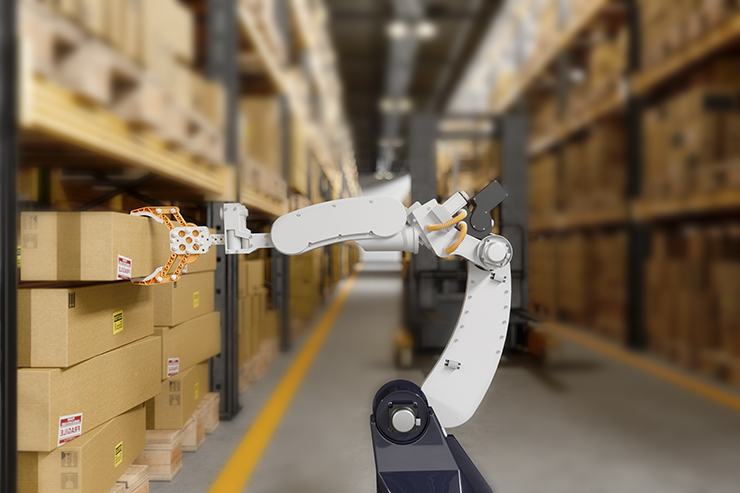|
Listen to this article  |
It is already old news that robots are revolutionizing industries like manufacturing, retail, farming, life sciences, etc. Such is the impact of robotic technologies– they are instrumental in creating efficiency, increasing productivity, and delivering secure experiences.
Robotic arms are among the most popular – given their wide range of use cases across multiple industries. For instance, they have helped warehousing companies to automate tedious, complex, or dangerous mission-critical tasks like picking up, sorting, and selecting items or components. In other industrial settings, robotic arms are utilized for material handling, machine tending, heavy lifting, etc. Robotic arms also play an important role in the smart farming industry as they can navigate rugged environments while picking/placing individual crops.

What are the ideal camera features for robotic arm devices?
Without a reliable camera solution, the robotic arm won’t be able to detect, identify, and locate objects. Even a single error or deviance can render the task useless. Robotic arms also get the intelligence from embedded vision technology – thereby being equipped to react and make decisions. Therefore, an effective camera solution helps gather all relevant information about their surroundings by capturing, processing, and analyzing imaging data in real-time.
Key camera features:
HDR
If robotic arms are a part of outdoor robots (e.g., farming robots), it is pertinent to reproduce the scene in contrasting lighting conditions accurately. Hence, the camera solution must be HDR-enabled to bring out the details in the brightest and darkest areas of the same scene.
Global shutter vs. Global reset mode
Often, robotic arms are required to capture images of high-speed moving objects. In that case, one of the key questions is whether to choose the rolling shutter, the global reset or the global shutter mode. The decision is based on factors such as the speed of the motion, the type of lighting conditions, etc. Going with the global shutter camera may seem like an easy decision in most cases. However, it’s important to know that the rolling shutter with the global reset mode (global reset release) can satisfy a majority of the needs.
High resolution
The higher resolution, the better the robotic arm-enabled device would be at capturing smaller objects. So, for instance, with a 4K resolution, it can capture even the smallest details of an object’s image. It will also become possible to zoom in on a Region of Interest (ROI) without compromising image quality.
Large pixel size
A large pixel size makes capturing images in low-light conditions easy as it aids in absorbing a higher number of photons. It can be a crucial feature of robotic arms that operate in outdoor environments. The larger the pixel size, the wider the Field of View coverage, the more effective the zooming, and the higher the resolution.
Flexible cabling
Many robotic systems must be empowered to handle long-distance data transmission without compromising on the delivery speed or accuracy of imaging. So, the camera solution must come with interfaces such as USB 3.0 or GSML 2 to transmit data up to a distance of 3 meters.
Other key camera features:
- High sensitivity
- High Signal to Noise Ratio
- Auto-exposure and white balance
- Superior depth measurement (to capture and analyze 3D coordinates)
How e-con Systems equips robotic arms with vision power
e-con Systems, with close to two decades of experience, has enabled several robotic arm devices with vision power. We have customized aspects, such as form factor, temperature tolerance, ISP tuning, lens calibration, and more.
- External trigger support to synchronize external sensors like IMU, LiDAR, GPS, etc., with multi-streaming support (up to 8 cameras) for 360-degree awareness, mapping, and navigation.
- Pixel-level processing to run heavy computer vision algorithms – edge AI processing platforms like NVidia edge AI processors.
- GMSL2 interface to transfer image data up to a distance of 15 meters.
- Multiple exposures in a single frame for bringing out sharp details in high-contrast lighting conditions.
Recently, e-con Systems partnered with a leading Korea-based manufacturer of sealant and visual inspection equipment to integrate their robotic arm product with the right camera solution. The camera had to be placed on a moving robotic arm, which meant that motion blur could pose a big problem. Also, given that it was a multi-camera setup, the system should be able to capture images synchronously.
Our solution comprised a custom-designed synchronous setup of six e-CAM55_CUMI0521_MOD modules connected to the NVIDIA Jetson board over a MIPI interface. We used GMSL coaxial cables between the host and cameras to support long-distance cabling.
Highlights
- Support for various image quality controls
- Perfect synchronization and low latency on the image pipeline
- Algorithms to instantly process high-quality images in memory
- Reliable performance in harsh environments and unpredictable lighting conditions
- Low exposure time to eliminate any chance of motion blur
In the end, the client could enjoy a high level of automation with lowered risk exposure, huge cost savings, and improved staff productivity.
Final thoughts
There are no off-the-shelf cameras that can fulfil every expectation of every robotic arm’s use case. So, the ability to customize based on unique needs should be a top priority. If you are looking for an expert to guide you through the process and help build a great robotic arm product, please write to us at [email protected].
Sponsored content by e-con Systems
Credit: Source link


Comments are closed.